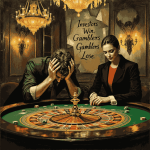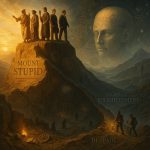The US Dollar: A Monument to Perception, Not Gold
Feb 25, 2025
“The greatest trick the devil ever pulled was convincing the world he didn’t exist.” – Charles Baudelaire
The Illusion of Stability: What Truly Backs the US Dollar?
The US dollar is not backed by gold, silver, or any tangible asset—it is propped up by belief, perception, and the unchallenged authority of the US government. The phrase “full faith and credit” is a masterstroke of linguistic alchemy, transmuting confidence into currency. In essence, the dollar is a promissory note backed by power, debt, and the psychological inertia of the masses.
But faith is fragile. History shows that every fiat currency eventually faces a reckoning. The US, with its $37 trillion national debt and escalating geopolitical tensions, is no exception. The dollar’s dominance persists not because of its intrinsic value but because there is no immediate alternative with the liquidity and trust to replace it. This is not a testament to strength but to the lack of viable challengers.
While some whisper of a return to gold, history reveals the flaws in such nostalgia. The gold standard was no utopia—fraud, manipulation, and financial panics plagued the system. Shaving gold coins, hoarding reserves, and strangling economies with rigid constraints were the norm.
So, what is the US dollar truly backed by? A global confidence game, reinforced by military supremacy and economic dominance. The question is not if this game ends, but when.
The Contrarian’s Take: Gold’s False Salvation
Many still cling to the notion that gold will reclaim its throne, but they fail to grasp the true nature of power. Currency is not about metal; it is about control. Central banks and policymakers will never willingly surrender their ability to manipulate money at will.
Gold may be scarce, but belief is scarcer still—and as long as the masses believe in the dollar, it will persist. The moment that faith cracks, the system collapses. But for now, the mirage holds.
Fiat currency is a paradox—it is simultaneously worthless and indispensable. The sooner one accepts this, the better positioned they are to navigate the shifting tides of global finance.
The Death of Gold: How Fiat Became King
In 1933, amidst the suffocating grip of the Great Depression, the U.S. government executed one of the most radical monetary shifts in history. Under President Franklin D. Roosevelt, Congress unleashed a barrage of laws and executive orders that shattered the gold standard, stripped gold of its legal tender status, and criminalized private ownership of significant gold holdings. The infamous Executive Order 6102 forced American citizens to turn in their gold under penalty of imprisonment, marking the beginning of an era where money was no longer tied to tangible wealth but to government decree.
At the time, the justification was clear: deflation was strangling the economy, and removing gold’s constraints would give policymakers the flexibility to print money and reflate prices. But what was framed as an emergency measure soon became permanent monetary doctrine. The Gold Reserve Act of 1934 devalued the dollar overnight by re-pegging gold from $20.67 to $35 per ounce, effectively robbing anyone who still held dollars instead of gold. This move not only made U.S. exports cheaper but also allowed the government to corner the world’s gold supply, tightening its grip on global finance.
Though many believed suspending the gold standard was temporary, reality dictated otherwise. By the time the U.S. officially abandoned the gold standard under Nixon in 1971, the masses had already been conditioned to accept paper money backed by nothing but faith. Fiat had won—not because it was superior, but because it allowed those in power to manipulate markets, inflate away debt, and control the financial system without restraint.
What began as a desperate act of survival in 1933 evolved into a global monetary experiment in which currency is no longer backed by scarcity but by belief. As history has shown, when belief wavers, the cracks in the system become impossible to ignore.
The Psychological Grip of Fiat Currency
Behavioural psychology plays a crucial role in understanding why people trust fiat currency. Humans are inherently driven by herd behaviour—a concept explored as far back as 2000 BC by ancient traders who observed collective madness during market frenzies. This same principle applies today, as the masses trust the US dollar not because of its intrinsic value but because everyone else does. This collective belief, however, can be both a strength and a vulnerability.
The concept of mass psychology in financial markets is not new. In the 1600s, philosopher Baruch Spinoza explored how emotions could overpower rational thought, leading to irrational market behaviour. Similarly, in the 20th century, behavioural economists like Daniel Kahneman and Amos Tversky introduced the idea of cognitive biases—systematic errors in judgment that affect financial decisions. These biases, such as the bandwagon effect, explain why people continue to place their faith in fiat currency, even when its underlying value is questionable.
Gold’s Illusion: The Fallacy of a “Safe Haven”
The Seduction of Gold: A Timeless Fixation, A Modern Delusion
Gold bugs revere the metal as the ultimate antidote to government mismanagement, fiat devaluation, and inflation. To them, gold is not just an asset—it is a beacon of financial purity, an incorruptible standard in a world of manipulated currencies. The argument is romantic, but like all romanticized notions, it wilts under scrutiny.
History is not kind to gold’s so-called infallibility. From Herodotus documenting gold shaving in 500 BC to European kings debasing coins to finance wars, gold has never been immune to manipulation. Even in the 20th century, governments have confiscated gold (see Roosevelt’s Executive Order 6102 in 1933) and imposed strict capital controls. Those who believe gold offers absolute security fail to understand that power, not metal, dictates monetary policy.
John Maynard Keynes dismissed the gold standard as a “barbarous relic,” and rightly so. A rigid gold-backed system strangles economies, forcing contractions instead of allowing flexible monetary responses. Gold’s historical appeal is undeniable, but its practicality in a world governed by digital transactions, instantaneous capital flows, and algorithmic trading is laughable.
The Brutal Truth: Gold Is No Longer Practical
Imagine a world where we revert to a gold-backed economy. Would you prefer carrying bars of gold or the simplicity of a digital transaction? The gold standard is a relic of a slower, more primitive financial era, one where transactions were measured in days, not nanoseconds.
The issue is not just weight or storage but control. A return to gold means surrendering monetary flexibility, removing the ability to respond to economic crises with targeted interventions. The very idea ignores a fundamental truth of human behavior—people crave convenience over ideology.
Rather than clinging to the past, solutions should focus on regulating the excesses of the current system. Fractional reserve banking, where banks lend money they do not have, fuels instability. Governments, addicted to deficit spending, create debt out of thin air. Fixing these issues does not require gold—it requires discipline, regulation, and an understanding that economic stability is not dictated by metal, but by trust.
Gold: The Ultimate Contrarian Asset in a World of Fiat Deception
Mass Psychology: The Fuel Behind Gold’s Resurgence
While gold has often been dismissed as a relic of the past, its recent performance tells a different story. The Tactical Investor recognized this shift early, closing positions at the peak in 2011 and re-entering once the cycle reset. Our target remains $5,000, and mass psychology is the key driver behind this move.
Markets are driven not by logic but by emotion—fear, greed, and herd mentality dictate asset flows. When investors lose trust in fiat systems, they seek refuge in tangible assets. Gold thrives when confidence in central banks declines, and with rising debt, geopolitical instability, and reckless monetary policies, trust is eroding fast.
Unlike digital wealth, which can vanish with a keystroke, gold has no counterparty risk. It is a hedge against uncertainty, an asset outside the reach of central bank manipulation. While some argue that gold’s inconvenience makes it obsolete, they ignore its true role: not as a medium of exchange, but as a store of value when trust collapses.
The Tactical Investor’s Approach: Profiting from Cycles, Not Ideology
The key to successful investing is understanding cycles. Gold was a screaming buy when sentiment hit rock bottom and mainstream analysts mocked it. The same crowd that dismissed gold is now quietly accumulating, and the pattern remains clear—gold will continue to rise as economic uncertainty deepens.
A $5,000 target is not just speculation; it is a logical outcome of today’s monetary policies. With nations racing to debase their currencies and financial instability rising, gold is no longer just a commodity—it is a psychological necessity. The masses may not fully grasp this yet, but when they do, the real parabolic move begins.
Gold is not about ideology; it is about understanding when the crowd will rush in. Those positioned early will reap the rewards, while those who mock it today will chase it at the top.
Conclusion: The Only Currency That Matters Is Power
The history of money is a history of human behavior—greed, fear, control. Whether it’s gold, paper, or digital code, value is an illusion sustained by collective belief. In the modern era, the US dollar persists not because it is superior, but because the world has yet to produce a better alternative.
Gold may shine, but it does not rule. Power does. And until that power shifts, the dollar—flawed as it may be—remains king.
One never needs their humour as much as when they argue with a fool.
Chinese Proverb Sayings of Chinese Origin















